Shumen
Shumen (Bulgarian: Шумен, also romanized as Shoumen or Šumen, pronounced [ˈʃumɛn]) is the tenth largest city in Bulgaria and the administrative and economic capital of Shumen Province.
Shumen
Шумен | |
|---|---|
Town | |
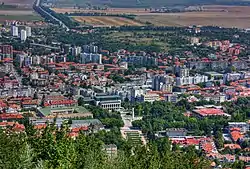 | |
 Flag  Seal | |
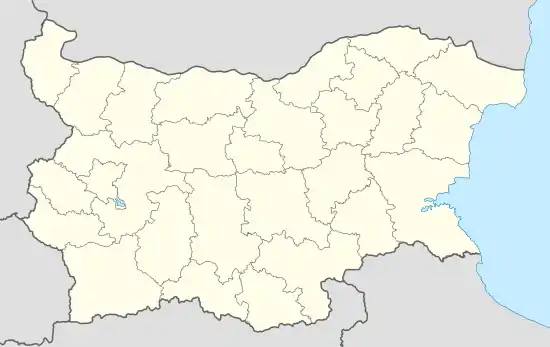 Shumen Location of Shumen  Shumen Shumen (Balkans) | |
| Coordinates: 43°17′N 26°56′E | |
| Country | |
| Province (Oblast) | Shumen |
| Government | |
| • Mayor | (GERB) Radie Radisheva |
| Area | |
| • Town | 136.358 km2 (52.648 sq mi) |
| Elevation | 184 m (604 ft) |
| Population (2021)[1] | |
| • Town | 72,342 |
| • Urban | 85,410 |
| Time zone | UTC+2 (EET) |
| • Summer (DST) | UTC+3 (EEST) |
| Postal Code | 9700 |
| Area code | 054 |
| License plate | H |
| Website | www.shumen.bg/en |
Etymology
The city was first mentioned as Šimeonis in 1153 by the Arab traveler Idrisi. The name is probably from Bulgarian shuma '(deciduous forest).'[2] Some believe Konstantin Jireček that it comes from the name of the Bulgarian emperor Simeon the Great. In the following periods, the city was mentioned with variants, such as Şumena, Şumna, Şumular, Sumunum, Şumnu and Şumen. The eleventh edition of the Encyclopædia Britannica lists it as Shumla,[3] similar to the way it lists Pleven as Plevna.
History
Antiquity and the Middle Ages

Earliest reports for Shumen fortress date back to the early Iron Age. From the 12th century BC is the first fort, surrounding accessible parts of the area. Archaeological surveys, conducted in 1957, 1961 to 1987, determined the chronological periods, the lifestyle and the livelihood of the inhabitants of the fortress. It had a wall thickness of about two meters, built of rough stones. In the 5th century BC a second wall was built in front of the former.
In the 2nd century the Romans built a military fortress on the ruins of the Thracian fortifications. The construction of the wall is already bonded to mortar; a tower was constructed above the gate; square tower was built to the west and semicircular to the south. In the 4-5th centuries the entire hill was fortified with a new wall with nine towers. Between the 8th and the 10th century the fort was renovated, for the purpose the Roman wall and towers were used and to the northeast was built a new wall with two towers.
In 681 khan Asparukh incorporated the territory into the First Bulgarian Empire. In 811 Shumen was burned by the Byzantine emperor Nicephorus. He was killed at the Battle of Pliska. Khan Krum of Bulgaria encased Nicephorus's skull in silver and used it as a cup for wine drinking. The Bulgarian fortification of the 7-10th centuries developed into a feudal city with a castle with surrounding inner and outer defensive zones, in which can be counted 28 towers and bastions, three gates and five small porticoes, and many churches and workshops (12th to 14th century). During the golden age of Bulgarian culture under Simeon the Great (893-927), Shumen was a centre of cultural and religious activity, and may have borne the name Simeonis.
During the Second Bulgarian Empire, Shumen was a significant military, administrative and economic center, displacing the old Bulgarian capital Preslav and developing outside the fortress. In the medieval city of Shumen the main religion was the Orthodox Christianity, evidence of which were the found in the outline of the walls, seven churches, commemorative coins with the image of crosses, angels, and numerous findings of Orthodox crosses separately, as well as their image on rings and on other artefacts, found in the graves and the homes. Change occurs only after the Ottoman conquest of the city in the 15th century, when Islam was introduced.
Ottoman Empire
In 1388 the sultan Murad I forced it to surrender to the Ottoman Empire.[3] After Władysław Warneńczyk's unsuccessful crusade in 1444, the city was destroyed by the Ottomans and moved to its present location. In the 18th century it was enlarged and fortified.[3] Three times (1774, 1810 and 1828) it was unsuccessfully attacked by Russian armies.[3] The Turks consequently gave it the name of Gazi ("Victorious").[3] In 1854 it was the headquarters of Omar Pasha and the point at which the Turkish army concentrated (see Crimean War).[3] Many Turks were settled in the area during the Ottoman period to spread the Islamic faith among the Slavic Bulgarian Christians and many Muslim Turkic men married Bulgarian women and converted them to Islam during the period .
Bulgarian National Revival
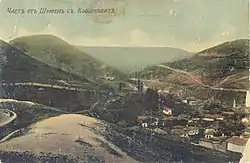
During the 19th century, Shumen was an important centre of the Bulgarian National Revival, with the first celebration of Cyril and Methodius in the Bulgarian lands taking place on 11 May 1813 and the first theatre performance. A girls' religious school was established in 1828; a class school for girls and a chitalishte (community centre) followed in 1856. The first Bulgarian symphony orchestra was founded in the city in 1850. In the same year, influential Hungarian politician and revolutionary leader Lajos Kossuth spent a part of his exile in the then-Ottoman town of Shumen. The house he lived in is preserved as a museum.
Kingdom of Bulgaria
On 22 June 1878 Shumen finally capitulated to the Russians and became part of the newly independent Bulgaria. In 1882 the Shumen Brewery, the first brewery in Bulgaria, was founded.
People's Republic of Bulgaria
In the period 1950–1965 the city was called Kolarovgrad, after the name of the communist leader Vasil Kolarov.
Geography
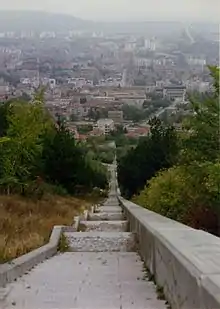
The city lies 80 kilometres (50 miles) west of Varna and is built within a cluster of hills, northern outliers of the eastern Balkans, which curve around it on the west and south in the shape of a horseshoe.[3] A rugged ravine intersects the ground longitudinally in the horseshoe ridge.[3]
From Shumen roads radiate northwards to the Danubian cities of Rousse and Silistra and to Dobruja, southwards to the passes of the Balkans, and eastwards to Varna and Balchik.[3]
Population
In January 2012, Shumen was inhabited by 80 511 people in the city limits, while the Shumen Municipality with the legally affiliated adjacent villages had 93 160 inhabitants.[4] The following table presents the change of the population after 1887. The number of the residents of the city (not the municipality) reached its peak in the period 1990-1991 when it exceeded 110,000.[5]
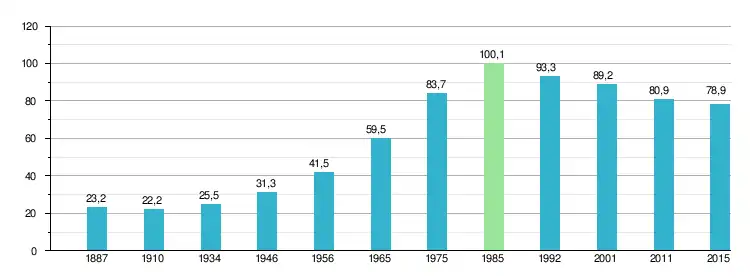
| Shumen | |||||||||||||||
|---|---|---|---|---|---|---|---|---|---|---|---|---|---|---|---|
| Year | 1887 | 1910 | 1934 | 1946 | 1956 | 1965 | 1975 | 1985 | 1992 | 2001 | 2005 | 2009 | 2011 | 2021 | |
| Population | 23,161 | 22,225 | 25,486 | 31,327 | 41,546 | 59,513 | 83,718 | 100,125 | 93,292 | 89,214 | 86,381 | 86,824 | 80,855 | 72,342 | |
| Highest number 112,091 in 1991 | |||||||||||||||
| Sources: National Statistical Institute,[5][6][1] citypopulation.de,[7] pop-stat.mashke.org,[8] Bulgarian Academy of Sciences[9] | |||||||||||||||
Ethnic, linguistic and religious composition
According to the latest 2011 census data, the individuals declared their ethnic identity were distributed as follows:[10][11]
- Bulgarians: 61,584
- Turks: 10,029
- Romani: 2,165
- Others: 600
- Indefinable: 552
- Undeclared: 5,925
Total: 80,855
Religion
The population of the city is majorly Eastern Orthodox, with a significant portion of Muslims and much smaller minorities of other religions.
In the Bulgarian Orthodox Church, Shumen is a part of the Eparchy (diocese) of Varna and Veliki Preslav and the capital of the Shumen church district (okolia). There are two major Orthodox temples in the city, the Church of the Holy Ascension (est. 1829) and the Church of the Three Holy Hierarchs (est. 1857), and a few chapels.
In Shumen is located the largest mosque in Bulgaria and the second largest on the Balkans, the Sherif Halil Pasha Mosque, more commonly known as the Tombul (or Tumbul) Mosque, built between 1740 and 1744.
Education and science
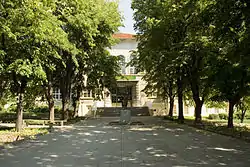
Shumen has 11 elementary and five common schools, as well as two high schools. The University of Shumen Episkop Konstantin Preslavski, the Artillery and Air Defense Faculty to the Vasil Levski National Military University and the Affiliate of Medical University of Varna are the higher education establishments in the city. The former operates a small astronomical observatory.
Sports
FC Shumen 1929 was the local football club since 2013 and the financial failure of PFC Shumen 2010. The club used the Panayot Volov Stadium as its home ground. Basketball, volleyball and handball are also represented, and most of the games are held at the 'Mladost' sports centre and Arena Shumen, the 2,300-seater indoor hall opened in 2018.
Other sporting activities include martial arts (mostly karate) and horse racing. Shumen has its own rallying tournament, the 'Stari Stolitsi'.
Climate
| Climate data for Shumen | |||||||||||||
|---|---|---|---|---|---|---|---|---|---|---|---|---|---|
| Month | Jan | Feb | Mar | Apr | May | Jun | Jul | Aug | Sep | Oct | Nov | Dec | Year |
| Average high °C (°F) | 4.3 (39.7) |
6.5 (43.7) |
11.3 (52.3) |
17.8 (64.0) |
23.2 (73.8) |
26.5 (79.7) |
29.5 (85.1) |
30.1 (86.2) |
25.1 (77.2) |
18.8 (65.8) |
12.0 (53.6) |
5.8 (42.4) |
17.6 (63.7) |
| Daily mean °C (°F) | 0.7 (33.3) |
2.6 (36.7) |
6.9 (44.4) |
12.5 (54.5) |
17.2 (63.0) |
20.6 (69.1) |
23.3 (73.9) |
23.7 (74.7) |
19.1 (66.4) |
13.5 (56.3) |
7.9 (46.2) |
2.4 (36.3) |
12.5 (54.5) |
| Average low °C (°F) | −2.9 (26.8) |
−1.3 (29.7) |
2.6 (36.7) |
7.1 (44.8) |
11.2 (52.2) |
14.7 (58.5) |
17.1 (62.8) |
17.2 (63.0) |
13.0 (55.4) |
8.1 (46.6) |
3.9 (39.0) |
−1.1 (30.0) |
7.2 (45.0) |
| Average precipitation mm (inches) | 36 (1.4) |
41 (1.6) |
38 (1.5) |
53 (2.1) |
64 (2.5) |
79 (3.1) |
48 (1.9) |
41 (1.6) |
33 (1.3) |
41 (1.6) |
53 (2.1) |
51 (2.0) |
580 (23) |
| Source: Weatherbase[12] | |||||||||||||
Main sights
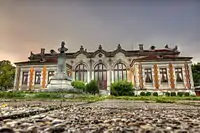
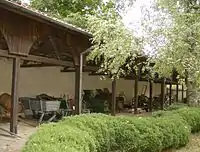
Shumen boasts the Monument to 1300 Years of Bulgaria, regarded as the only monument in the world to depict the history of a whole country from its creation to the present day.
The Shumen Fortress, partially restored after being destroyed by the Ottomans, is an important historical monument of the medieval Bulgarian Empire. It is not far from the city on the Shumen Plateau.
The Regional Historical Museum, which is a successor of the Archaeological Society created in Shumen in 1904 by Rafail Popov.
The Madara Horseman, a World Heritage Site and the only such example of medieval rock art in Europe, is an ancient (710 AD) monument usually attributed to the Bulgar culture. It lies some 20 km (12 mi) from Shumen.
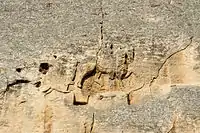
The religious buildings in the city include the Eastern Orthodox Holy Three Saints Cathedral and Holy Ascension Basilica, as well as the Sherif Halil Pasha mosque (also known as the Tombul Mosque), the largest mosque in Bulgaria and one of the largest in the Balkans, serving Shumen and the region's Muslim minority.
Kurşun çeşme is a fountain built in 1774 built in the times of Ottoman Empire.
_-_Shumen%252C_Bulgaria.jpg.webp)
People
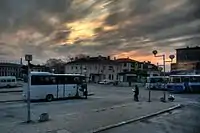
- Maxim Behar (born 1955), public relations expert
- Hacho Boyadzhiev (1932–2012), film director
- Stoyan Danev (1858–1949), politician, twice prime minister of Bulgaria
- Ivan Dochev (1906–2005), anti-communist politician
- Vasil Drumev (Clement of Tarnovo) (1841–1901), clergyman and politician, twice Prime Minister of Bulgaria
- Solomon Goldstein, (1884–1969), politician
- Nikolay Gunderov (born 1974), award-winning playwright, stage director, poet, and actor
- Yusuf İsmail (1857–1898), wrestler
- Vasil Kolarov (1877–1950), politician, Communist leader
- Todor Kolev (1939–2013), actor
- Racho Petrov (1861–1942), a leading Bulgarian general and politician
- Ahmet Fikri Tüzer (1878–1942), Prime Minister of Turkey for one day (8–9 July 1942), born in what was then Şumnu
- Slavena Vatova (1989) Miss Bulgaria 2006
- Veneta Vicheva (1931–2013), choir conductor
- Pancho Vladigerov (1899–1978), composer, pedagogue and pianist
- Panayot Volov (1850-1876), organizer and leader of the Gyurgevo Revolutionary Committee of the Bulgarian April Uprising against the Ottoman Empire in 1876
- Dobri Voynikov (1833–1878), writer and enlightener
- Nadezhda Panayotova, voice actress and singer
- Toni Storaro (born 1976), singer, songwriter
International relations
Honour
Shumen Peak on Livingston Island in the South Shetland Islands, Antarctica is named after Shumen. The tails of the Bulgarian currency lev are the same as the seal of Shumen, showing the Madara Rider, 15 km (9 mi) away from the city.
References
- https://nsi.bg/bg/content/2975/%D0%BD%D0%B0%D1%81%D0%B5%D0%BB%D0%B5%D0%BD%D0%B8%D0%B5-%D0%BF%D0%BE-%D0%BE%D0%B1%D0%BB%D0%B0%D1%81%D1%82%D0%B8-%D0%BE%D0%B1%D1%89%D0%B8%D0%BD%D0%B8-%D0%BC%D0%B5%D1%81%D1%82%D0%BE%D0%B6%D0%B8%D0%B2%D0%B5%D0%B5%D0%BD%D0%B5-%D0%B8-%D0%BF%D0%BE%D0%BB
- E.M. Pospelov, Geograficheskie nazvaniya mira (Moscow: Russkie slovari, 1998), p. 475.
- Chisholm, Hugh, ed. (1911). . Encyclopædia Britannica. Vol. 24 (11th ed.). Cambridge University Press. p. 1023.
- (in Bulgarian)National Statistical Institute - 2012 Archived 13 November 2012 at the Wayback Machine
- (in Bulgarian)National Statistical Institute - Towns population 1956-1992
- (in English) Bulgarian National Statistical Institute - towns in 2009
- (in English) „WorldCityPopulation"
- ""pop-stat.mashke.org"".
- (in Bulgarian) Bulgarian Academy of Sciences Archived 6 July 2011 at the Wayback Machine
- (in Bulgarian) Population on 01.02.2011 by provinces, municipalities, settlements and age; National Statistical Institute
- Population by province, municipality, settlement and ethnic identification, by 01.02.2011; Bulgarian National Statistical Institute (in Bulgarian)
- "Shumen, Bulgaria Travel Weather Averages (Weatherbase)". Weatherbase.
- "Podolsk sister cities". Retrieved 29 April 2010.
